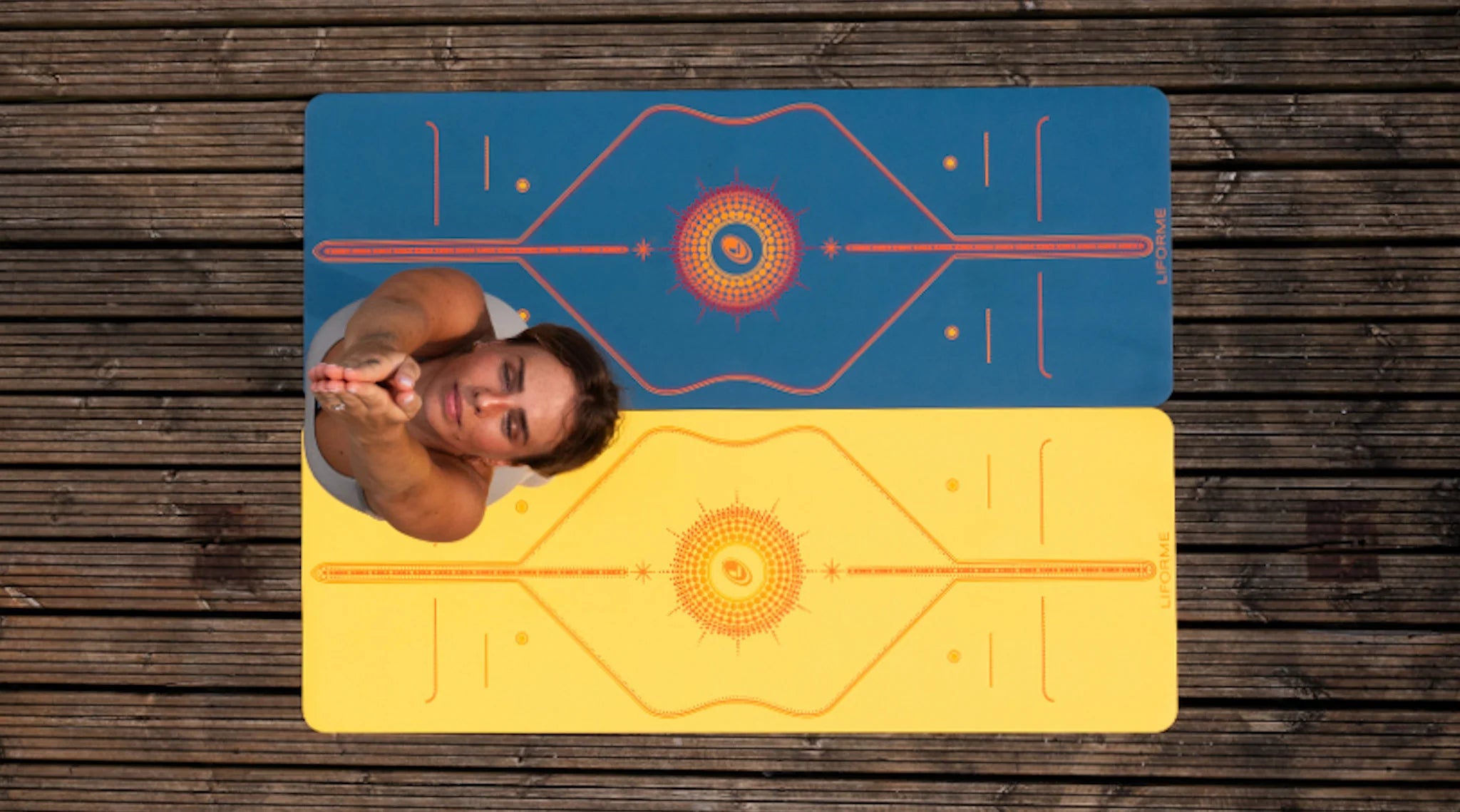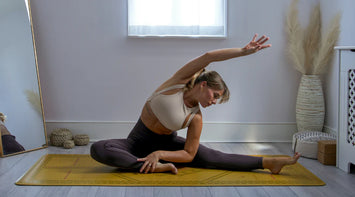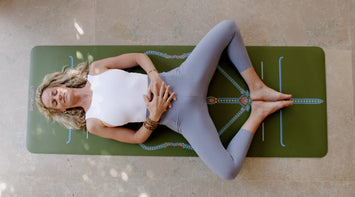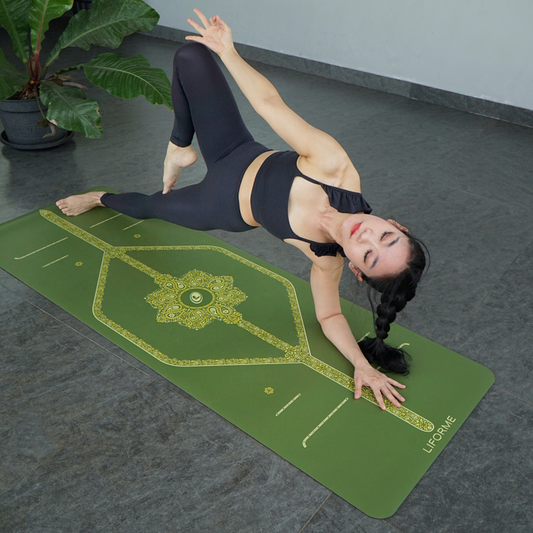Sun Salutations (Surya Namaskar in Sanskrit) are at the heart of Vinyasa Flow yoga. Yogis all over the world are united by the ritual of stepping to the tops of our mats and aligning our bodies in Mountain Pose in preparation for this classic sequence of postures. As we lift our arms and gazes to the sky, we are invited to acknowledge the life-giving force of our nearest star. Light, warmth, and the power of nature suffuse us as we salute the sun.
Surya Namaskar connects so many yogic principles: unity, devotion, integration of breath and movement, balance. They are an integral part of modern yoga, but, like many of the poses we do today, they likely haven’t been included in postural practice for that long. Read on for more on their origin, evolution, benefits, and step-by-step instructions.
The Origin of Sun Salutations
Asana, the word we use to describe the physical practice of yoga, means ‘seat’ in Sanskrit. Aptly, the earliest yoga poses that we’re aware of in historic texts are seated poses intended to facilitate meditation. Standing poses came much later and the inclusion of movement from pose to pose is an even more recent innovation.
In his book Yoga Body, historian Mark Singleton dates the antecedents of the modern Surya Namaskar system to 1930s India, during which time the international physical culture movement (including gymnastics, calisthenics, and bodybuilding) began to merge with more traditional practices to create the hybrid that characterises our contemporary yoga styles.
The Evolution of Sun Salutations
The shala of T. Krishnamacharya, often considered the Father of Modern Yoga, at the Maharaja’s palace in Mysore, was instrumental in the canonisation of Sun Salutations. This is where K. Pattabhi Jois, soon to be the founder of Ashtanga Yoga, learned the sequences that became Sun A (see below) and Sun B in the Ashtanga Primary Series.
As Jois began to attract a global cadre of students to Mysore in the 1970s, Ashtanga Yoga, particularly the Primary Series, spread. Before long, Vinyasa Yoga, including Surya Namaskar, was being taught around the world, where it was further adapted into the practice of Power Yoga and became an important part of the flowing styles of yoga so many of us now enjoy.
The Mental and Physical Benefits of Sun Salutations
Many yoga classes begin with Sun Salutations because they warm up your body and help you get into the yoga headspace. Moving from the front to the back of your mat in conjunction with the rhythm of your breath creates the framework for Vinyasa practice.
Poses like Standing Forward Fold and Downward Facing Dog initiate the process of releasing tension from your hamstrings, shoulders, and back. Flowing from pose to pose lubricates your joints with synovial fluid and begins to raise your heart rate. The internal heat that facilitates the opening of your body begins to build.
At the same time, the repetition of this familiar sequence creates a separation between your daily life and your time on the mat. Focusing on the coordination of your breath and movement absorbs your attention, clearing your mind. Anxiety and stress begin to recede from your primary awareness.
Preparing for Sun Salutations
Since Sun Salutations are a warm-up, you don’t need to do anything specific to prepare. If you are on your mat a few minutes early, seated hip openers can help loosen your hips and hamstrings.
Sit in Easy Pose (Sukhasana) with a folded blanket under your bum, close your eyes, and begin to notice the inhalations and exhalations of your breath. This prepares you for a breath-centred practice.
Step-by-Step Guide to Sun Salutations
 Mountain Pose (Tadasana)
Mountain Pose (Tadasana)
- The sequence begins when you come to stand in Mountain Pose at the front of your mat.
- Even if you’ve done thousands of Sun Salutations, take this time to align your body and bring your attention to the present.
- To find your body’s most neutral alignment, stand with your arms at your sides and your palms facing forward.
- Bring your hands to Anjali Mudra at your sternum if you want to set an intention for your practice.
 Inhale to Raised Hands Pose (Urdhva Hastasana)
Inhale to Raised Hands Pose (Urdhva Hastasana)
- On an inhalation of breath, lift your arms out to the sides and up toward the ceiling.
- If bringing your palms to touch overhead causes your shoulders to shrug up then it’s better to keep your palms separate.
- Keep your hands active so that energy flows to the tips of your fingers as your feet ground into the earth.
 Exhale to a Forward Fold (Uttanasana)
Exhale to a Forward Fold (Uttanasana)
- On an exhalation, lower your arms to either side in a wide arc as you hinge at the hips to forward fold over your legs.
- Shift some of your weight in the balls of your feet to keep your hips over your ankles.
- Let your hands come to the floor and relax your neck.
 Inhale to a Flat Back (Ardha Uttanasana)
Inhale to a Flat Back (Ardha Uttanasana)
- On an inhalation, come up onto your fingertips or bring your palms to your shins in order to bring your spine flat.
- Lift your head so that it’s the natural extension of your spine and let your gaze come to the floor about a foot in front of your toes.
Exhale to a Forward Fold (Uttanasana)
- On an exhalation, return to a forward fold.
- Maybe you can go a little deeper now that you’ve been stretching your hamstrings for a bit.
- Make sure to let your head hang freely.
 Inhale to Plank Pose
Inhale to Plank Pose
- On an inhalation of breath, step or jump your feet to the back of your mat to come into a Plank position.
- If the feet don’t land exactly right, make adjustments so that they are equidistant from the Central Line and your shoulders are over your wrists.
 Exhale to Four-Limbed Staff Pose (Chaturanga Dandasana)
Exhale to Four-Limbed Staff Pose (Chaturanga Dandasana)
Stop!
Before you lower to Chaturanga, set yourself up for the safest alignment in that posture. To do this, come forward on your tippy-toes. This shifts your shoulders in front of your wrists so that when you lower you can bring the forearms perpendicular to the floor.
- On an exhalation, bend your elbows back to lower your chest.
- Keep the elbows hugging your ribs and stop lowering when your upper arms are parallel to the floor.
- It’s fine to stop before the upper arms come to a parallel position but do not allow your shoulders to dip below the level of your elbows.
- If you feel yourself collapsing toward the floor, drop your knees to the mat.
 Inhale to Upward Facing Dog (Urdhva Mukha Svanasana)
Inhale to Upward Facing Dog (Urdhva Mukha Svanasana)
- On an inhalation, move to your heart opener by pressing into your palms to straighten your arms, dropping your hips toward (but not touching) your mat and moving from toes tucked to the tops of your feet.
- Though rolling over the toes is popular, it often causes your shoulders to move in from your wrists, so try flipping the feet one at a time.
- Keep a little softness in your elbows so you can roll your shoulders back and hug your shoulder blades onto your back to move your chest through your upper arms in an open position.
- Let your gaze lift a bit naturally, but don’t throw your head back.
 Exhale to Downward Facing Dog (Adho Mukha Svanasana)
Exhale to Downward Facing Dog (Adho Mukha Svanasana)
- On an exhalation, press into your palms and flip to the balls of your feet (one at a time or simultaneously) to lift your hips up and back, coming into the inverted V shape that is Downward Facing Dog.
- Keep pressure in your palms as you roll your upper arms externally to broaden your shoulder blades and release your neck.
- Relax your heels toward the floor.
- You may take several breaths in Downward Facing Dog or move on after a single inhalation if you’re going for a brisker pace.
Exhale to a Forward Fold (Uttanasana)
- On an exhalation of breath, step or jump your feet to the front of your mat.
- Land in a forward fold.
Inhale to Flat Back (Ardha Uttanasana)
- On an inhalation, come to your fingertips or bring your hands to your shins to come to a flat back in your forward fold.
Exhale to a Forward Fold (Uttanasana)
- On an exhalation, return to a full forward fold.
Inhale to Raised Hands Pose (Urdhva Hastasana)
- On an inhalation, take your arms out to the sides and up to the ceiling as you return to standing with the arms overhead.
Exhale to Mountain Pose (Tadasana)
- On an exhalation, release your arms to a neutral position on either side on your body.
Modifications
1. Step or Jump:
You can choose to jump back from your Forward Fold to Plank or directly into Chaturanga. When it’s time to move to the front of your mat, you can jump or step from Downward Facing Dog to Forward Fold.
2. Modify Your Vinyasa Sequence:
Substitute Knees, Chest, and Chin for Chaturanga or lower your knees for your Chaturanga.
Substitute Low Cobra (Bhujangasana) for Upward Facing Dog any time you choose.
Sun Salutations in Different Practices
The basic structure of a Sun Salutation offers myriad opportunities for innovation, variation, and modification. The Ashtanga tradition relies on set series of poses, so their Sun A and Sun B are always the same. Other styles and individual teachers are free to change the sequence however they choose. The many iterations of Moon Salutations are also variations.
Sunny-Side Up
If you ever get on your mat and you’re not sure what to do, Sun Salutations are the answer. Start with three rounds if you are practising at home. Once you get going, other poses often flow naturally. Adding on a sequence of standing poses or a Warrior sequence is good way to build a practice.
Take the opportunity that Surya Namaskar presents to connect to your breath and your body, other people that are practicing the same poses, whether in the same room or elsewhere in the world, and the tradition of yoga that brings us together.






































